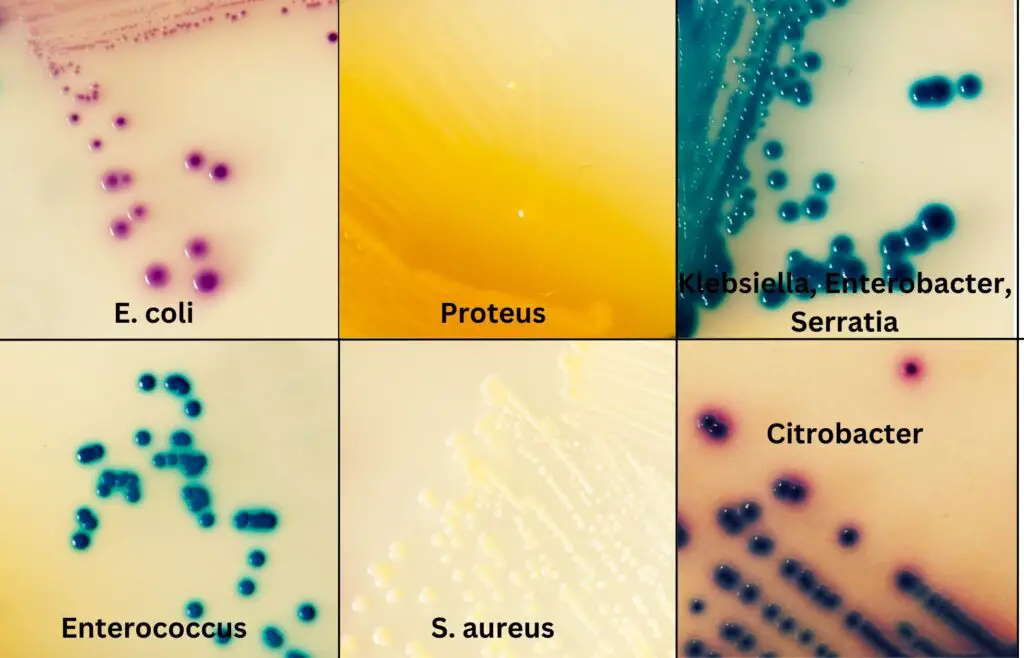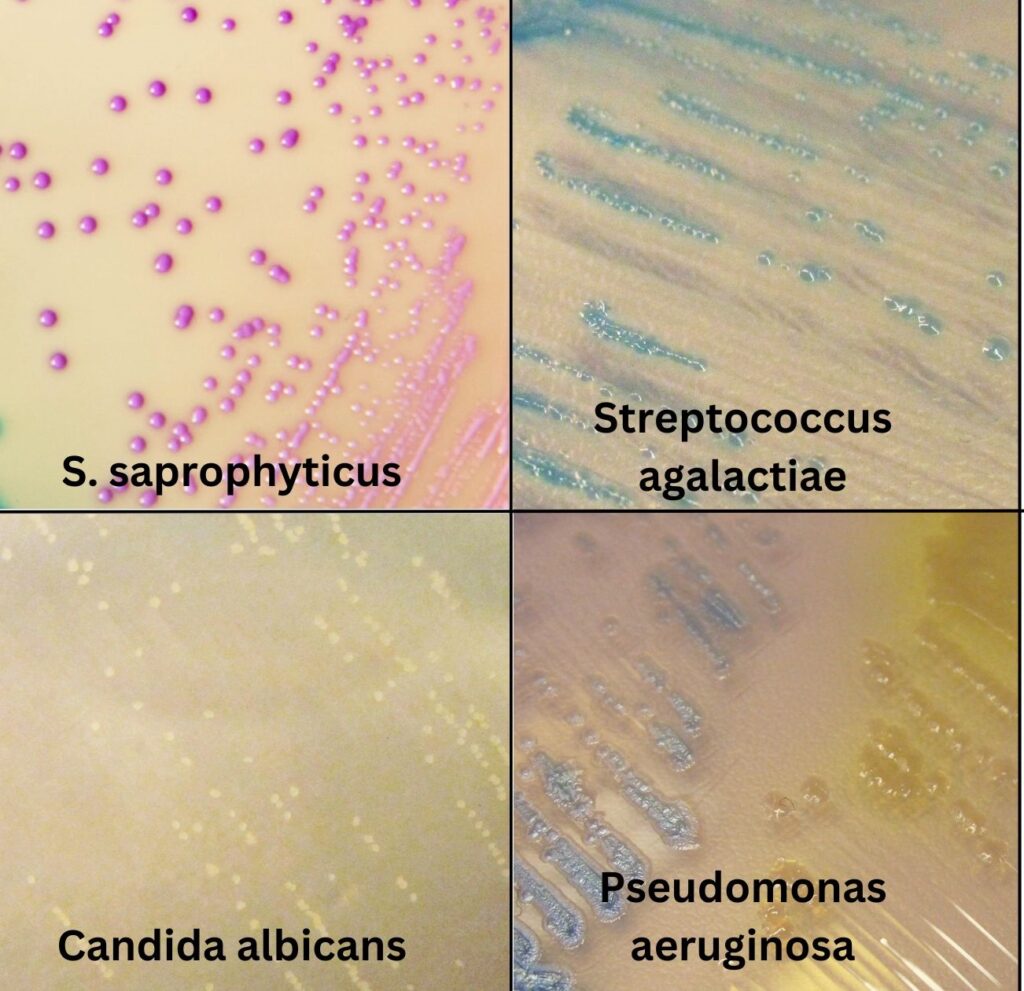Table of Contents
What is CHROMagar?
- CHROMagar is a chromogenic culture medium that was invented and patented by Dr. A. Rambach in 1979. It is a color-based differentiation method used for the detection and identification of specific microorganisms, such as E. coli. The technology is based on soluble colorless molecules called chromogens, which consist of a substrate that targets a specific enzymatic activity and a chromophore.
- In the presence of the target microorganism, its specific enzyme cleaves the colorless chromogenic conjugate, leading to the release of the chromophore. The chromophore, now in its unconjugated form, exhibits a distinctive color and forms a precipitate due to reduced solubility. This color and precipitate formation are easily visible to the naked eye under normal lighting conditions. As a result, colonies of specific microorganisms can be recognized by their unique color, allowing for easy identification and differentiation.
- The use of CHROMagar helps eliminate false positive results and enables technicians to focus on accurately identifying contaminated samples. By providing a specific and visually distinguishable color reaction, CHROMagar simplifies the process of microbial identification, making it more efficient and reliable in various laboratory settings.
Composition of CHROMagar
| Ingredients | Gm/L |
| Peptone | 8.0 |
| Sodium chloride | 5.0 |
| Sodium deoxycholate | 1.0 |
| Chromogenic mix | 1.5 |
| Polypropylene glycol | 10.5 |
| Agar | 15.0 |
pH 7.4 ± 0.2 at 25°C
Principle of CHROMagar
The principle of CHROMagar is based on specific components and reactions within the agar medium that allow for the differentiation and identification of different bacteria, particularly within the Enterobacteriaceae family. Here’s an overview of the principle of CHROMagar, based on the provided information:
- Nutritive substrates and sodium deoxycholate: The nutritive substrates present in CHROMagar promote the rapid multiplication of Enterobacteriaceae. Sodium deoxycholate inhibits the growth of accompanying Gram-positive flora, focusing the growth on the target organisms.
- Propylene glycol differentiation for Salmonella: Propylene glycol is added to the culture medium, enabling the unambiguous differentiation of Salmonella species from other bacteria. Salmonellae produce acid when they interact with propylene glycol, resulting in the characteristic red color of their colonies.
- Peptone and sodium chloride: Peptone provides essential nitrogen and vitamins for the growth of the microorganisms. Sodium chloride helps maintain osmotic equilibrium, ensuring the integrity of bacterial cells.
- Chromogen for differentiation of coliforms: The medium contains a chromogen that indicates the presence of β-galactosidase, which is characteristic of coliforms. Lactose-fermenting bacteria that produce β-galactosidase yield blue-violet-colored colonies.
- Color reactions of Salmonella and other enteric bacteria: Salmonella Typhimurium and Salmonella Enteritidis produce pink to red colonies due to their acid production from propylene glycol. Other enteric gram-negative bacteria form colorless to yellowish colonies.
By incorporating these components and reactions into the medium, CHROMagar allows for the differentiation and identification of specific bacteria, particularly Salmonella and coliforms, based on the color reactions of their colonies. The distinct colors aid in the easy recognition and differentiation of different microbial species within the Enterobacteriaceae family.
Preparation of CHROMagar
The preparation of CHROMagar involves several steps to ensure proper dissolution and pouring of the medium. Based on the provided information, here is a summary of the preparation process:
- Add components to water: Add the required components of CHROMagar to distilled or deionized water, following the specified amounts to prepare a total volume of 1.0 L.
- Thorough mixing: Mix the components thoroughly to ensure even distribution and dissolution.
- Heat and suspension: Heat the mixture in a boiling water bath or expose it to a current of steam while intermittently shaking. This heating process helps dissolve the medium. The medium should be completely suspended, with no visible particles sticking to the glass walls.
- Avoid further heat treatment: Once the medium is fully suspended, it should not be subjected to additional heat treatment or autoclaving. Overheating should be avoided.
- Dissolution with shaking: Complete dissolution of the medium is achieved through intermittent shaking in 5-minute sequences, which takes approximately 35-40 minutes. Continue shaking to aid in the dissolution process.
- Cooling: Cool the medium rapidly to a temperature of 45°–50°C while gently shaking the container. Rapid cooling helps prevent any precipitates or clotting of the chromogenic mix in the plates.
- Pouring into Petri dishes: Once the medium has reached the desired temperature, pour it into sterile Petri dishes. During the pouring procedure, place the Petri dishes on a cool surface (maximum 25°C) to prevent any unwanted precipitates or clots from forming.
- Appearance of the plates: After pouring, the plates will have an opaque and pink appearance, which is characteristic of CHROMagar.
Following these preparation steps ensures the proper formulation and presentation of CHROMagar for use in microbial culture and identification. It is essential to adhere to the specified instructions and maintain a sterile environment during the preparation process to obtain accurate and reliable results.
Result on CHROMagar
The interpretation of results on CHROMagar is based on the distinctive color reactions of different microorganisms. Here’s an interpretation guide based on the provided information:
- Salmonella: Salmonella species typically produce red or intense mauve colonies on CHROMagar. This color is the result of their ability to produce acid when interacting with propylene glycol, which is included in the medium. The red or intense mauve color is a characteristic feature of Salmonella colonies on CHROMagar.
- Coliforms: Many coliform bacteria, including lactose-fermenting organisms that possess β-galactosidase activity, produce blue-green or blue-violet colonies on CHROMagar. The chromogen present in the medium reacts with these coliforms, resulting in distinct coloration.
- Proteus and Pseudomonas: Proteus and Pseudomonas species typically form colorless to yellowish colonies on CHROMagar. These organisms do not exhibit the same color reactions as Salmonella or coliforms on the medium.
By observing the color of colonies formed on CHROMagar, one can differentiate between Salmonella, coliforms, Proteus, and Pseudomonas. This color-based differentiation aids in the rapid identification and preliminary characterization of these microorganisms. It is important to note that additional confirmatory tests and procedures may be required for a comprehensive identification of specific bacterial species.


Uses of CHROMagar
CHROMagar has several applications in microbiology, food safety, and clinical diagnostics. Here are the key applications based on the provided information:
- Differentiation of organisms based on colony color:
- CHROMagar allows for the differentiation of microorganisms based on the specific colors of their colonies. This color-based differentiation simplifies the identification process and enables quick visual recognition of different species.
- Differential-diagnostic culture medium:
- CHROMagar serves as a valuable culture medium for the identification of organisms in various samples, including foodstuffs and clinical specimens. The distinctive colony colors aid in the rapid and preliminary diagnosis of different types of microorganisms.
- Supplementary agar for Salmonella testing in foods:
- Rambach agar, a specific variant of CHROMagar, shows potential as a supplementary agar in the detection of Salmonella in food samples. It can be used alongside other testing methods to enhance the accuracy and efficiency of Salmonella detection.
- Rapid detection of specific pathogens:
- Enzyme detection methods using chromogenic agar, such as CHROMagar, offer rapid and reliable detection of specific pathogens in food and water microbiology.
- CHROMagar enables the rapid detection of important foodborne pathogens such as Clostridium perfringens, Listeria monocytogenes, Bacillus cereus, and Staphylococcus aureus.
Overall, CHROMagar provides a versatile platform for differentiating and identifying microorganisms based on colony color. Its applications extend to various fields, including clinical diagnostics, food safety, and water microbiology, enabling rapid and efficient detection of specific pathogens of interest.
FAQ
What is CHROMagar?
CHROMagar is a specialized culture medium that allows for the differentiation and identification of microorganisms based on the distinct color reactions of their colonies.
How does CHROMagar work?
CHROMagar contains specific chromogens that react with enzymes produced by target microorganisms. These reactions result in color changes of the colonies, aiding in their identification.
What are the advantages of using CHROMagar?
CHROMagar offers several advantages, including easy visual recognition of different microorganisms, simplified identification based on colony color, and the ability to detect multiple species on a single agar plate.
Can CHROMagar be used for clinical diagnostics?
Yes, CHROMagar is commonly used in clinical diagnostics to identify pathogens in various clinical samples, such as urine, stool, wound swabs, and respiratory specimens.
Can CHROMagar be used for food microbiology?
Absolutely, CHROMagar is utilized in food microbiology to detect and differentiate foodborne pathogens, aiding in the rapid and reliable identification of specific organisms.
Is CHROMagar suitable for environmental monitoring?
Yes, CHROMagar can be applied in environmental monitoring to detect and enumerate specific microorganisms in water, air, and other environmental samples.
How long does it take to obtain results using CHROMagar?
Results can be observed within 24 to 48 hours of incubation on CHROMagar, making it a relatively rapid method for identifying microorganisms.
Can CHROMagar detect multiple microorganisms simultaneously?
Yes, CHROMagar can detect multiple microorganisms simultaneously on a single agar plate due to the different color reactions produced by each organism.
Is additional confirmation required after using CHROMagar?
Yes, while CHROMagar provides initial identification, further confirmatory tests and procedures may be required for definitive identification of microorganisms.
What are some common microorganisms that can be identified using CHROMagar?
Common microorganisms that can be identified using CHROMagar include Escherichia coli, Salmonella spp., Enterococcus faecalis, Staphylococcus aureus, and various species of Candida.
References
- https://d1vffmuvmgkypt.cloudfront.net/pdf/ridacom_ltd/himedia_laboratories/69_hicrome_booklet_0007.pdf
- https://www.chromagar.com/en/product/chromagar-orientation/
